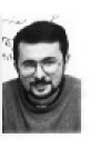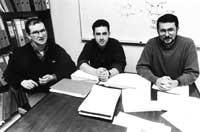Conversing with José María Asua
Elh.- First of all, our most sincere congratulations.
J. M. A. - Thank you!
Elh.- Could you explain in a few words the reason for the prize?
J. M. A.- Before starting I want to clarify something. Although the award has been promoted by the French chemical company Rhone Poulenc, it is the company of engineers of Madrid that is in charge of delivering it. The award rewards clean chemical technologies and work done for their development.

As you know we work with polymerization reactors, processes that are performed by emulsion reactions. Many reaction residues are generated in these processes and our work has been to develop a reaction control system to reduce them. I want to make it clear that we have not carried out any waste recycling process. We have only managed to minimize the waste generated in the process.
Elh.- What is the process?
J. M. A.- First of all I want to give a couple of details about emulsion polymerizos. In this type of process, and in all polymerizations in general, only external controls are made on the development and status of the process, such as temperature and pressure. It does not analyze what is happening inside the reactor, that is, the reaction. Therefore, if in the industrial process something happens that cannot be controlled through these external controls, you can waste all the reaction and, for example, you must throw 15 tons of stone products because it does not have an adequate quality. Look! I don't want to say that he throws himself into the river! That has huge economic losses.
We have put means for this not to happen. Development of a control system for polymerization reactors. The process consists of two parts: a physical, sampling of the reactor and analysis of what is happening, and another computer, control of the working conditions of the reactor from the data obtained.
You may be surprised, but the key to the control process is sample collection. Why: An emulsion polymerization system with 55% latex is very conflictive and charming, like gum. No problem when taking the first sample of the reactor. However, when you take the second or third sample, the sampling tube will probably be clogged and impossible for you. Our system breaks the blockage and it is possible to make samples continuously. Therefore, it is possible to know at all times what is happening inside the reactor.
The sample is passed through a gas chromatograph and shows how polymerization is developing by analyzing the current monomer. The infomatic control system, taking into account the data collected from the gas chromatograph, will adjust the reaction conditions according to the desired result. For the purpose of its physical materialization, the feed pump is considered to put into operation a greater or lesser feed flow from or from this monomer. It is a system of intelligent, iterative control, in constant learning based on theoretical and experimental parameters to adapt to the process that is taking place.

Fdo.- At what level have you done the process? Have you made a pilot plant?
J. M. A.- The prototype we have works at the pilot plant level but works in industrial conditions as an industrial plant. That is, in our case scale increase is not a problem, but the confrontation of latex.
Elh.- What kind of industry will your application process have?
J. M. A.- In those who perform emulsion polymerizations, of course, in the coating and adhesive industry.
Elh.- Have other emulsion polymerization control processes developed in the world?
J. M. A.- Our system is not the only one in the world, of course. For example, General Electric Plastics is developing another with other analysis techniques. However, and this is the most developed control system in the world for emulsion polymerization.
The work of José María Asua and his companions is not a joke. However, we will conclude the transcript of the long and interesting conversation we had with José María Asua. Many things, such as his point of view of research, remain to be mentioned, since two pages do not allow anything else.
- Born in Zaratamo in 1953
- Bachelor of Chemistry from the Autonomous University of Bilbao
- PhD in Chemistry from the University of Zaragoza
- Professor at the Faculty of Chemistry of San Sebastian since 1978
- Professor in 1983
- Professor in 1987
- Head of the Erasmus programme for two years
Chemical Engineering Team of the Faculty of Chemistry of San Sebastian
- 35 researchers working. Of them 8 are university professors and other fellows and hired
- 8 foreign researchers from Germany, Argentina, Great Britain, France, Cuba, Mexico and Sweden
- Three major lines of research:
- study and control of polymerization reactors
- catalysts
- environmental pollution studies - Research funding
- 60% public money (Diputación Foral de Gipuzkoa, Basque Government, Ministry of Education and European
Association) - 40% contracts with industries.
Buletina
Bidali zure helbide elektronikoa eta jaso asteroko buletina zure sarrera-ontzian











